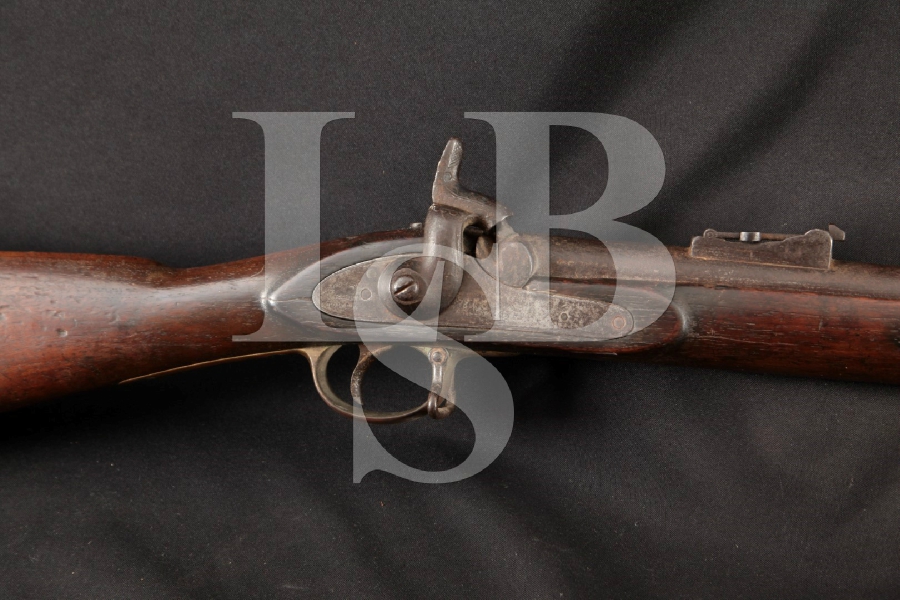
J. E. Barnett P-1853 Enfield “Tower” Musket, In The White 39” Percussion Single Shot Rifle, MFD 1860s Antique
Sold For: $1,005.00
LSB#: 170211JH60
Make: J.E. Barnett & Sons, London
Model: P-1853 Musket
Serial Number: 309
Year of Manufacture: 1860’s
Caliber: .577 Caliber Percussion
Action Type: Single Shot Cap and Ball
Markings: The left side of the barrel is marked “309” and with three British view marks we can’t make out. The lockplate is marked at the rear with “Crown /Tower” and in front of the hammer with “BARNETT / LONDON”.
Barrel Length: The barrel is 39” in length.
Sights / Optics: The front sight is a short blade fixed to a rectangular base on the barrel. The rear sight is a combination sliding elevator and ladder sight that is screwed to the barrel. The base has four steps and the right side of the base is marked “1 2 3 4” for use with the slider as an elevator sight. The right side of the ladder is marked from “5” to “8”. There is a “V” notch at the front of the ladder when it is folded down and used as an elevator sight, and a “V” notch in the top edge of the slider and in the top of the ladder for use as a ladder sight.
Stock Configuration & Condition: The stock is one piece walnut with a straight grip, flat brass buttplate, a brass trigger guard and a brass nosecap. The forend, which reaches to about 3” from the muzzle, is held with three steel barrel bands. The underside of the forend and the nosecap are grooved for a ramrod (not included). The wood is dark with oil staining around the receiver and the barrel bands. There is a crack in the wrist at the back edge of the lockplate and a finishing nail in the left side above the front of the trigger guard, although there is no crack at this location. The stock has a lacquered finish which is mostly worn off on the left side of the buttstock. There are several dings and bruises in the right side of the buttstock, numerous more in the forend and a few long drag lines in the left side of the buttstock. The LOP measures 13” from the front of the trigger to the back of the buttplate. The buttplate fits the butt well but is slightly proud of the wood at the toe. The buttplate has developed a mottled mustard colored patina and shows several tiny dings and a scratch. The buttplate is in about Very Good condition. The stock rates in about Good condition.
Type of Finish: The patina on the metal is too thick to determine the original finish. We think the barrel and lockplate were “In The White”, with the rest of the furnishings brass. The hammer is scroll engraved.
Finish Originality: There are no indications that the metal was ever refinished.
Bore Condition: The bore is dark and the rifling is so worn as to be smoothbore. There is moderate erosion the length of the bore.
Overall Condition: This rifle retains about 0% of its metal finish. The barrel, barrel bands and hammer have developed a thick dark patina with solid erosion throughout. The lockplate is lightly pitted. The nosecap and lower tang have a red coating, which we think is stain that was applied to the wood. The trigger guard has a dark patina. The screw heads are distressed. The lockplate markings are clear, but the view marks on the barrel are obscured by erosion. Overall, this rifle rates in about Good condition.
Mechanics: The action functions correctly, but the forward barrel band is loose. The nipple is intact. We have not fired this rifle. As with all used firearms, a thorough cleaning may be necessary to meet your maintenance standards.
Box, Paperwork & Accessories: None
Our Assessment: From: https://www.collegehillarsenal.com/shop/product.php?productid=1337: “There is no English gun maker who could more appropriately be called the “Gun Maker to the Confederacy” than the London firm of John Edward Barnett & Sons. During the course of the American Civil War, Barnett delivered thousands of P-1853 “Enfield” rifle muskets, as well as P-1853 artillery and P-1856 cavalry carbines to the Confederacy. Barnett not only filled Confederate central government contracts, but also orders for the Confederates states of Georgia, North Carolina, and South Carolina. The Barnett family traced their gunmaking heritage to Thomas Barnett who operated in London as early as 1796. In 1811 the firm became Thomas Barnett & Sons, and John Edward Barnett subsequently succeeded to the business in 1833. In 1842 the firm was renamed JE Barnett & Sons and operated under that name until 1901 when they became JE Barnett & Sons LTD, going out of business in 1908. During the Civil War years, the Barnetts operated at both their 134 Minories address, which had been established in 1833, and at Brewhouse Lane, Wapping, where they operated from 1860-1874. “. The P-1853 muskets were used on both sides during the Civil War, but the larger number purchased by the South from Barnett almost guarantees that this is a Confederate rifle. The rifle is in about Good overall condition with none of its original finish remaining. The bore is dark with very shallow rifling and moderate erosion. Still, there can’t be that many of these rifles that survived the Civil War and are still around today, making all of them collectible regardless of their condition. We think that this rifle will end up in a Civil War collection next to the 1861 Springfield musket and the various carbines in use during the war.

